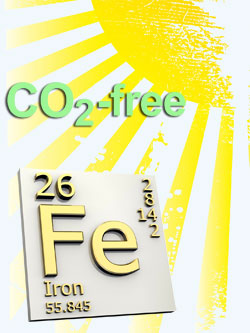A more environmentally friendly way of producing iron developed by scientists in the US and China could reduce industrial carbon dioxide emissions by a quarter worldwide.
Since the beginning of the industrial revolution, iron metal has been produced by melting iron ore at temperatures over 2000°C in a blast furnace. This produces large amounts of CO2, which is released into the atmosphere and contributes to climate change.
The new method developed by Stuart Licht at George Washington University in Washington, DC and Baohui Wang at Northeast Petroleum University in Daqing could result in completely CO2-free iron production. The team show that iron ores (Fe2O3 and Fe3O4) can be dissolved in molten lithium carbonate at temperatures of around 800°C – a process that was previously thought impossible. Adding an electrical current to the molten mix separates the iron ore into its component parts, iron and oxygen, which can be collected by two electrodes in the solution.
Less energy is required to generate the lower temperatures and power the electrolysis, but Licht also demonstrates that these can be achieved using renewable energy. The team employ their recently developed solar technique, called solar thermal electrochemical photo (Step) – which uses the Sun’s thermal energy to melt the lithium carbonate solution while the visible light energy powers the electrolysis. Using the Step process no CO2 is produced.
‘Step production of iron would be cost effective, and could allow iron production facilities to be housed in new geographic locations, such as in closer to urban centres or in high sunlight geographies,’ says Licht, as well as eliminating one of the major contributors to global carbon dioxide emission.
Neal Woodbury, a renewable energy expert at Arizona State University, US, comments ‘if the Step process can be performed at industrial scale, it holds considerable promise. Of particular note is that it should be possible to utilise waste heat from the processes that produce the required electricity, thus decreasing the energy input as well.’
Licht has previously shown that the Step technology can be used for carbon capture and for generating hydrogen fuel. And says he sees the scale-up of CO2-free iron production from the laborartory to industry as an exciting challenge.
Emma Shiells
Read the whole story in the ChemComm article.











